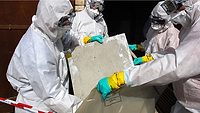Common Pitfalls to Avoid When Selecting PPE for Restoration & Remediation Work
Essential Guidance for Restoration and Remediation Professionals on Selecting Gloves and Respirators

Photo: Andrey Grigoriev/iStock / Getty Images Plus via Getty Images
When performing restoration and remediation work, various hazards can pose risks to worker health when proper protective equipment (PPE) is not provided for use. Unfortunately, both employers and workers often make mistakes when choosing the right PPE, especially in two critical areas: selecting proper hand protection when working with hazardous chemicals, and selecting adequate respiratory protection devices for use to protect against atmospheric hazards.
Selecting the Proper Hand Protection for Chemical Exposure
Chemical-resistant gloves are made from many different materials, including natural rubber, nitrile, latex, butyl, and neoprene. However, each of these materials may only offer adequate protection against specific chemicals, as opposed to universal protection against all chemicals.
For instance, protective gloves made from natural rubber are highly effective when used when working with acetone, a toxic chemical solvent frequently used in some restoration tasks. However, that same rubber glove will break down rapidly when exposed to xylene, another commonly used solvent that is toxic, resulting in the user’s skin being exposed to the chemical. Therefore, it is essential to understand that a glove that works well when exposed one chemical may not be suitable for use when working with another.
To ensure the proper selection of gloves for specific chemical exposure, consider referencing the following resources:
- Occupational Safety and Health Administration (OSHA): OSHA’s Publication #3151, "Personal Protective Equipment", which includes a detailed “Chemical Resistance Selection Chart for protective gloves.
- Product Safety Data Sheets (SDS): Refer to section 8 of the SDS for the chemical product, "Exposure Controls/Personal Protection," which provides recommended glove materials. These sheets are typically available from chemical distributors, as well as the manufacturers of the chemicals.
- Glove Manufacturers' Product Information: Many manufacturers provide chemical resistance ratings for various glove materials based on their performance with different chemicals.
Proper Selection of Respiratory Protection
Silica, asbestos, and organic vapors are but a few of the potential atmospheric hazards that often come into play when workers perform restoration and remediation work. So, it is It is imperative to select the right type of respiratory protection device relative to the type(s) of atmospheric hazards present on the job. In addition, selecting the right type of respiratory protection device can be even more challenging than when selecting protective gloves, as there are multiple variables that can come into play.
Not all respirators provide adequate protection against all respiratory hazards. Take the time you need to choose a respirator that is certified for use to protect against the contaminant of concern. The National Institute for Occupational Safety and Health, aka NIOSH, is the federal government agency responsible for certifying respirators. A label or statement of certification typically appears on the respirators or its packaging. This label explains which hazards the respirator and its components (e.g.: detachable filters or chemical cartridges) are designed to protect against, and also the level protection it will provide.
A good example is dust masks and respirator filters used for protection against nuisance dusts and similar particulate matter generated during tasks such as sweeping the floor or sanding wood are generally rated by NIOSH as an N-95. However, respirators with filters suitable for protection against moderate levels of super-fine particulate, like crystalline silica generated when cutting or grinding concrete, masonry products, or quartz and granite should be rated as high efficiency particulate air, or HEPA, filters.
The level of air contaminant present in the air will dictate the type of respirator to be used. According to OSHA respiratory protection standards, half-mask respirator with OV cartridges typically provides adequate protection against exposures to lower levels (no more than 10 times the permissible exposure limits established by OSHA) of organic vapors, such as those present when working with many oil-based paints, stains, strippers, and solvents.
Exposure to much higher levels of OV’s could require the use of a full-face respirator with OV cartridges (adequate up to 50 times the PEL), or even a supplied air respirator in cases where there is much higher levels of chemical exposure. The level of exposures to vapors and gasses, coupled with the length of exposure, dictate how often chemical cartridges must be changed so as to ensure adequate employee protection is provided. Measurement of the levels of exposure to atmospheric hazards is typically determined by a qualified technician such as a certified industrial hygienist or safety professional.
One final word about use of respiratory protection devices. Whenever workers are required to wear respirators when performing their jobs, the employer must implement a full-blown respiratory protection program. And that can require some extensive measures be taken, such as the development of a written respiratory protection program, medical examinations for respirator users, initial and annual respirator training, and initial/annual respirator fit-testing.
Additional information about permissible exposure limits for atmospheric hazards can be obtained in Subpart Z of the Federal OSHA 1910 standards, and information about the requirements for implementing a respiratory protection program are found in the Federal OSHA 1910.134 standards. Both can be accessed on the Federal OSHA website.
Looking for a reprint of this article?
From high-res PDFs to custom plaques, order your copy today!





